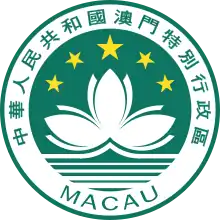National Emblem of the People's Republic of China
The National Emblem of the People's Republic of China is a national symbol of the People's Republic of China and contains in a red circle a representation of Tiananmen Gate, the entrance gate to the Forbidden City, where Mao Zedong declared the foundation of the People's Republic of China (PRC) in 1949. Above this representation are the five stars found on the national flag. The largest star represents the Chinese Communist Party (CCP), while the four smaller stars represent the four social classes as defined in Maoism. The emblem is described as being "composed of patterns of the national flag":[1]
...The red color of the flag symbolizes revolution and the yellow color of the stars the golden brilliant rays radiating from the vast red land. The design of four smaller stars surrounding a bigger one signifies the unity of the Chinese people under the leadership of the Communist Party of China (CPC).
—China Yearbook 2004[2]
| National Emblem of the People's Republic of China | |
|---|---|
 | |
| Armiger | |
| Adopted | 20 September 1950 |
| National Emblem of the People's Republic of China | |||||||||
|---|---|---|---|---|---|---|---|---|---|
| Simplified Chinese | 中华人民共和国国徽 | ||||||||
| Traditional Chinese | 中華人民共和國國徽 | ||||||||
| |||||||||
The outer border of the red circle shows sheaves of wheat and the inner sheaves of rice, which together represent agricultural workers. At the center of the bottom portion of the border is a cog-wheel that represents industrial workers.
According to The Description of the National Emblem of the People's Republic of China (中华人民共和国国徽图案说明), these elements taken together symbolise the revolutionary struggles of the Chinese people since the May Fourth Movement and the coalition of the proletariat which succeeded in founding the People's Republic of China.
History
The national emblem appearing in modern times is often designed directly based on European heraldry. But in fact, the development of national emblem design in human society also has a long process. As a symbol of a country, even without the artistic concept of European heraldry, human beings will explore totem worship with similar concept in social practice. For example, there was no legal national emblem in the Qing Dynasty, but the "dragon" totem in the "Yellow Dragon flag" was widely used as a substantive national emblem in the official designs of the government such as silver coins and passports.[3]
In the early days of the People's Republic of China, there was also the design of the national seal with the nature of the national emblem. In ancient China, the national seal was the certificate of the emperors of the orthodox dynasties in previous dynasties. Its symbolic power and stamping effect were similar to that of the modern national emblem. When the people's Republic of China was just established, it also took the traditional seal designed based on the traditional seal as an official duty (for example, the national seal "seal of the Central People's Government of the people's Republic of China" in the National Museum of China), but later it was officially changed to the European round seal design.[4]
Beiyang period

The Empire of China during the Manchu-led Qing dynasty did not have an official state emblem, but the flag featured the azure dragon on a plain yellow field with a red sun of the three-legged crow in the upper left corner. It became the first national flag of China and is usually referred to as the Yellow Dragon Flag.
Following the end of Manchu rule, new national symbols were deemed necessary by the leaders to represent the changed circumstances. The renowned writers Lu Xun, Qian Daosun, and Xu Shoushang from the Ministry of Education were tasked with designing a new national emblem. It was presented on August 28, 1912, and was adopted as national emblem in February 1913. President-Emperor Yuan Shikai continued its use during his short imperial reign from 1915 to 1916. The emblem is based on the ancient symbols of the Twelve Ornaments.[5] These are first mentioned as already ancient in the Book of Documents by Emperor Shun, who was one of the legendary Three Sovereigns and Five Emperors. Oral tradition holds that he lived sometime between 2294 and 2184 BC.[6] According to the book, the emperor wished for the symbols to be used on official robes of the state.
Nationalist period
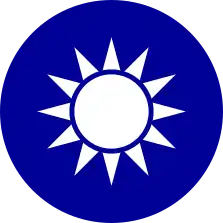
The Northern Expedition led by General Chiang Kai-shek and the Kuomintang party led to the overthrow of the fractious yet internationally recognized Beiyang government in 1928. This ushered in a one-party state under the Kuomintang known as the Nanjing decade. The state emblem was therefore replaced with the Kuomintang Blue Sky with a White Sun party symbol. The "Blue Sky, White Sun, and a Wholly Red Earth" flag has remained the flag of the Republic of China to this day. During this period, under the KMT's political tutelage, the Blue Sky with a White Sun Flag shared the same prominence as the ROC flag. A common wall display consisted of the KMT flag perched on the left and the ROC flag perched on the right, each tilted at an angle with a portrait of National Father Sun Yat-sen displayed in the center. After the promulgation of the Constitution of the Republic of China, the party flag was removed from such a display and the national flag was moved to the center.
Since the ROC government moved to Taiwan and especially in the years since the end of martial law the Kuominmtang flag has lost some of its prominence. However, it is still frequently seen on KMT party buildings in political rallies and other meetings of KMT and the pan-blue coalition.
Communist period
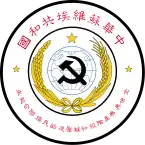
_logo.svg.png.webp)
The first communist government in China known as the Chinese Soviet Republic had the emblem adopted in 1934. It consisted of an hammer and sickle on a globe, and the grain ears are placed under and on both sides of the earth. Above the earth and the five-pointed star is written the "Chinese Soviet Republic" on the top, and the "Workers of the world, unite!" written on the bottom.
On July 10, 1949, the government held a public competition for the design of the national emblem, however no satisfactory designs were selected. Therefore, on September 27, 1949, the First Plenary Session of Chinese People's Political Consultative Conference (CPPCC) decided to invite designers for the proposals of the national emblem and two groups from two universities were selected in September 1949. Three proposals were selected for the first round discussion:
- The designers from China Central Academy of Fine Arts, Zhang Ding, Zhang Guangyu, Zhou Lingzhao and Zhong Ling, handed out their proposals with 5 variations on September 25, 1949. The symbolism of their first design was: The red star symbolizes Communism and the CCP. The cog and wheat/rice symbolizes unification of industrial workers and peasants. The rising earth with China in red symbolizes the socialist revolution in China and the world revolution ideal on Asian counties. 31 rays behind the earth symbolizes the 31 provincial administrative divisions at that time. The name of the People's Republic of China is written on the red ribbon below.[7] The design was based on their design of the emblem of CPPCC, and was influenced by Socialist heraldry of the Eastern Bloc.
- The designers from the Department of Architecture at Tsinghua University, Liang Sicheng, Lin Huiyin, Mo Zongjiang, Zhu Changzhong, Li Zongjin and Gao Zhuang, handed their proposal on October 30, 1949. According to their proposal, the design was a mixture of traditional Chinese culture and Maoist New Democratic Revolution ideals. The design imitated the style of mirrors in Han dynasty, symbolizing brightness. The disc was made of jade, a symbol of peace and unity. Decorative carvings on the disc was in Tang dynasty style. The stars from national flag and a cog were placed in the center of the disc, surrounded by wheats, symbolizing unity of working class and socialism. The red ribbon tied a smaller jade ring, symbolising the unification of Chinese people.[8]
- The other proposal by Zhang Ding, Zhang Guangyu, Zhou Lingzhao, was a perspective depiction of Tian'anmen gate.
- First round proposals of the national emblem
 Proposals of China Central Academy of Fine Arts, September 25, 1949
Proposals of China Central Academy of Fine Arts, September 25, 1949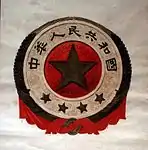 Proposal of Tsinghua University, October 30, 1949
Proposal of Tsinghua University, October 30, 1949

Members of the first CPPCC committee discussed these three proposals on June 10, 1950. The result of the discussion was, the China Central Academy of Fine Arts proposal was too colourful to be regarded as trademarks, and proposal from Tsinghua University was regarded as bourgeois due to its use of traditional symbols. The committee suggested the groups include the Tian'anmen Gate, a symbol of Chinese revolution that served as the location of the May Fourth Movement and foundation ceremony of the People's Republic of China on October 1, 1949.[9]
The two groups then worked on a second round of proposals. The second proposal from Tsinghua University standardized the design of the Tian'anmen Gate on the emblem and selected red and yellow as the main colours.[10] Their proposal was selected and the design was standardized and simplified by Gao Zhuang.[11] This design was officially made the national emblem on 20 September 1950 by the Central People's Government.
- Second round proposals of the national emblem
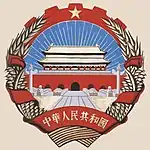 Proposal of China Central Academy of Fine Arts
Proposal of China Central Academy of Fine Arts
June 15, 1950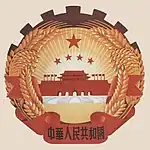 Proposal of China Central Academy of Fine Arts
Proposal of China Central Academy of Fine Arts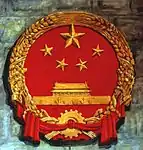 Proposal of Tsinghua University
Proposal of Tsinghua University
June 17, 1950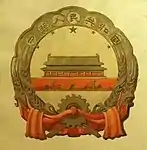 Proposal of Tsinghua University
Proposal of Tsinghua University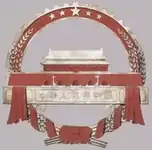 Proposal of Tsinghua University
Proposal of Tsinghua University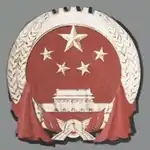 Proposal of Tsinghua University
Proposal of Tsinghua University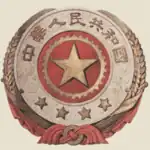 Proposal of Tsinghua University
Proposal of Tsinghua University
The emblem is also displayed, along with the national flag, at the end of a video clip with the national anthem, March of the Volunteers, regularly played on Chinese television such as state-run China Central Television (CCTV) on a daily basis.
Construction
National standard of China: GB 15093-2008 specifies the construction, material and color of the national emblem.
| Proportion | Construction |
|---|---|
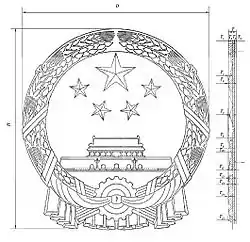 | 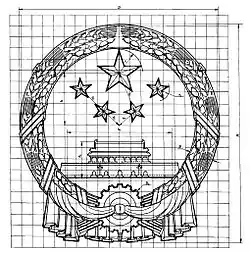 |
Emblems of subdivisions
Before the Communist takeover of Mainland China, the ROC had provinces design their own emblems. Only two emblems were used so far.
On April 15, 1985, Taiyuan City officially announced its emblem, becoming the first city in the People's Republic of China to have a city emblem.
Hong Kong and Macao each have their own emblem. The National People's Congress have passed the standardized use of the two special administrative regions' emblems.
Under Chinese law since November 1997, only Hong Kong and Macau are allowed to have their own emblems and other localities that had them had to stop using theirs.[12] This rule was ignored in 2011 when the city of Chengdu chose the Golden Sun Bird found under the city's Jinsha site as its emblem.[13]
Historical emblems
 Imperial Seal of the Ming dynasty.
Imperial Seal of the Ming dynasty. Imperial Seal of the Qing dynasty.
Imperial Seal of the Qing dynasty. Taiping Heavenly Kingdom (1851–1864)
Taiping Heavenly Kingdom (1851–1864)
 Blue Sky with a White Sun emblem of the Republic of China (1928–present) and the Roundel of the Republic of China Air Force (1991–present)
Blue Sky with a White Sun emblem of the Republic of China (1928–present) and the Roundel of the Republic of China Air Force (1991–present) Roundel of the Republic of China Air Force (1928–1991)
Roundel of the Republic of China Air Force (1928–1991)_1949_-1991.svg.png.webp) Roundel of the Republic of China Air Force (1928–1991), light version
Roundel of the Republic of China Air Force (1928–1991), light version Emblem of Chinese Taipei used during the Olympic Games (1981–present)
Emblem of Chinese Taipei used during the Olympic Games (1981–present)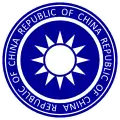 Emblem of the Republic of China with encircling text as depicted on ROC passports (2021–present)
Emblem of the Republic of China with encircling text as depicted on ROC passports (2021–present) Emblem of the Chinese Soviet Republic (1934–1937)
Emblem of the Chinese Soviet Republic (1934–1937) North Shanxi Autonomous Government (1937–1939)
North Shanxi Autonomous Government (1937–1939) Mengjiang (1939–1945)
Mengjiang (1939–1945) Imperial Seal of Manchukuo (1932–1945)
Imperial Seal of Manchukuo (1932–1945) Shanghai International Settlement (pre WWI)
Shanghai International Settlement (pre WWI)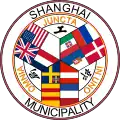
 Emblem of the National Reorganized Government of the Republic of China (1940–1945)
Emblem of the National Reorganized Government of the Republic of China (1940–1945)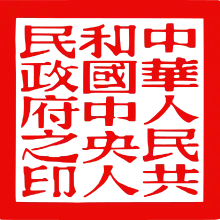
 Emblem of the People's Republic of China (1950–present)
Emblem of the People's Republic of China (1950–present)
References
- Description of the National Emblem from Chinese Government web portal. Archived 2012-05-02 at the Wayback Machine
- National flag Archived 2007-06-04 at the Wayback Machine
- 肖聰榕(Xiao Congrong).探析国徽设计的历史流变(Analyze the historical changes of national emblem design[J].工业设计,2021(03):76-77.
- 肖聰榕(Xiao Congrong).探析国徽设计的历史流变(Analyze the historical changes of national emblem design[J].工业设计,2021(03):76-77.
- Description of proposed national emblem to the state council - Lu Xun, February 1913
- Williams, C.A.S (2001). Chinese Symbolism and Art Motifs (4th ed.). Tuttle Publishing. p. 386. ISBN 0-8048-3704-X.
- 国徽图案参考资料, Reference on proposals of national emblem, 1949.
- 徐志摩诗文网 Archived 2013-05-14 at the Wayback Machine, 拟制国徽图案说明, Explanation of national emblem proposal
- 到底是谁设计了国徽,新华网
- 正投影 国徽设计中亮丽的一笔 Archived 2013-05-14 at the Wayback Machine
- 高庄:命运多舛的国徽浮雕定型设计者
- 中共中央办公厅、国务院办公厅关于禁止自行制作和使用地方旗、徽的通知 (Chinese Communist Central Governmental Notice to Ban Making and Using Local Flags and Emblems)
- "Chengdu Unveils its New City Logo". news.ifeng.com. 2011-12-30. Retrieved 2012-09-30.
- "Seal of the People's Government of the People's Republic of China". Retrieved Jun 16, 2021.
External links
 Media related to National Emblem of the People's Republic of China at Wikimedia Commons
Media related to National Emblem of the People's Republic of China at Wikimedia Commons

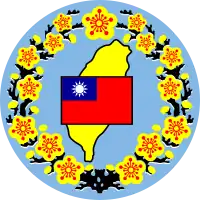


.svg.png.webp)



